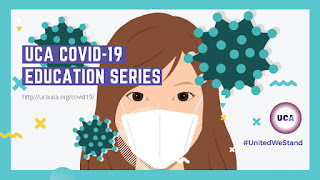17: Preventing fecal-oral transmission—Things to pay attention to at home
Q: What is fecal-oral transmission?
💁Tracy: Fecal-oral transmission results from the digestive tract containing large amounts of pathogens (such as virus). After excretion of fecal matter, due to feces directly contaminating food, or feces contaminating hands and indirectly contaminating food, pathogens enter the body through the digestive system, resulting in infection.
Q: Why is it important to pay attention to fecal-oral transmission?
💁Tracy: COVID-19 nucleic acids have been detected in the fecal matter of patients, so if there are confirmed/suspected cases or people who are in close contact with patients (including healthcare workers and volunteers) at your home, you should pay attention to preventing fecal-oral transmission routes.
Q: How do you prevent fecal-oral transmission?
💁Tracy:
A: Bathrooms
B: Food
[2] https://www.cdc.gov/coronavirus/2019-ncov/prepare/cleaning-disinfection.html
[3] https://www.cdc.gov/coronavirus/2019-ncov/hcp/guidance-prevent-spread.html
[4] https://www.health.com/condition/infectious-diseases/coronavirus/how-long-does-coronavirus-live-on-clothes
[5] Charleen Yeo, Sanghvi Kaushal, Danson Yeo, Enteric involvement of coronaviruses: is faecal–oral transmission of SARS-CoV-2 possible? The Lancet,2020, VOLUME 5, ISSUE 4, P335-337.
[6] Xu, Y., Li, X., Zhu, B. et al. Characteristics of pediatric SARS-CoV-2 infection and potential evidence for persistent fecal viral shedding. Nat Med (2020).
💁Tracy: Fecal-oral transmission results from the digestive tract containing large amounts of pathogens (such as virus). After excretion of fecal matter, due to feces directly contaminating food, or feces contaminating hands and indirectly contaminating food, pathogens enter the body through the digestive system, resulting in infection.
Q: Why is it important to pay attention to fecal-oral transmission?
💁Tracy: COVID-19 nucleic acids have been detected in the fecal matter of patients, so if there are confirmed/suspected cases or people who are in close contact with patients (including healthcare workers and volunteers) at your home, you should pay attention to preventing fecal-oral transmission routes.
Q: How do you prevent fecal-oral transmission?
💁Tracy:
A: Bathrooms
- Those in close contact with patients as well as those isolating at home, please use the bathroom separately from other members of the household (refer to bathroom disinfecting instructions).
- Before and after going to the bathroom, you must wash your hands.
- Prevent the urine from spilling or splashing outside of the toilet. If you worry about this, after urinating, you can use disinfecting wipes to wipe the toilet lid, the flushing button/lever, and the seat. Before flushing, put the toilet cover down.
- Pour a small amount of bleach into the toilet or condition toilet water tank with a bleach tablet in order to further clean the fecal matter that has not been flushed completely.
- Be careful with ventilation. If the bathroom has shared ventilation with another room, then you should cover the ventilating duct to prevent possible spread of virus through air duct.
- If the bathroom has a ventilating fan that goes to the outside of the house (open to fresh air outdoors), please turn on the ventilating fan before using the bathroom, let the fan run during the time you are using the bathroom.
B: Food
- Those in close contact with patients (including healthcare workers or volunteers) as well as those who are isolating at home, should stay in separate areas from other family members. Eat separately, and use separate utensils. Disinfect utensils after each use. If disinfection is difficult, try disposable utensils.
- Clean up utensils, dinnerwares and leftover food after each meal. Please wear disposable gloves. Food and used disposable utensils should be sealed in a garbage bag. Throw away the bag after sealing.
- To disinfect non-disposable utensils, boil or steam for 20 minutes, or use the dishwasher at high temperatures. For utensils that are heat-intolerate, after washing, soak in disinfecting bleach for 30 minutes, then wash again with water.
Tracy’s Toolbox
Disposable gloves, bleach, toilet brush, disinfecting wipes, alcohol-based hand sanitizer, 70%+alcohol
|
Reference
[1] WHO: Home care for patients with suspected novel coronavirus (nCoV) infection presenting with mild symptoms and management of contacts..[2] https://www.cdc.gov/coronavirus/2019-ncov/prepare/cleaning-disinfection.html
[3] https://www.cdc.gov/coronavirus/2019-ncov/hcp/guidance-prevent-spread.html
[4] https://www.health.com/condition/infectious-diseases/coronavirus/how-long-does-coronavirus-live-on-clothes
[5] Charleen Yeo, Sanghvi Kaushal, Danson Yeo, Enteric involvement of coronaviruses: is faecal–oral transmission of SARS-CoV-2 possible? The Lancet,2020, VOLUME 5, ISSUE 4, P335-337.
[6] Xu, Y., Li, X., Zhu, B. et al. Characteristics of pediatric SARS-CoV-2 infection and potential evidence for persistent fecal viral shedding. Nat Med (2020).
Writing: Yuehan Wu; Translation: Chaoyu Xie; Proofreading: Xiao Luo, Suzhen Jiang, Helen Shih; Artwork: Jiehuan Liu
Disclaimer and Copyright © 2020 United Chinese Americans








